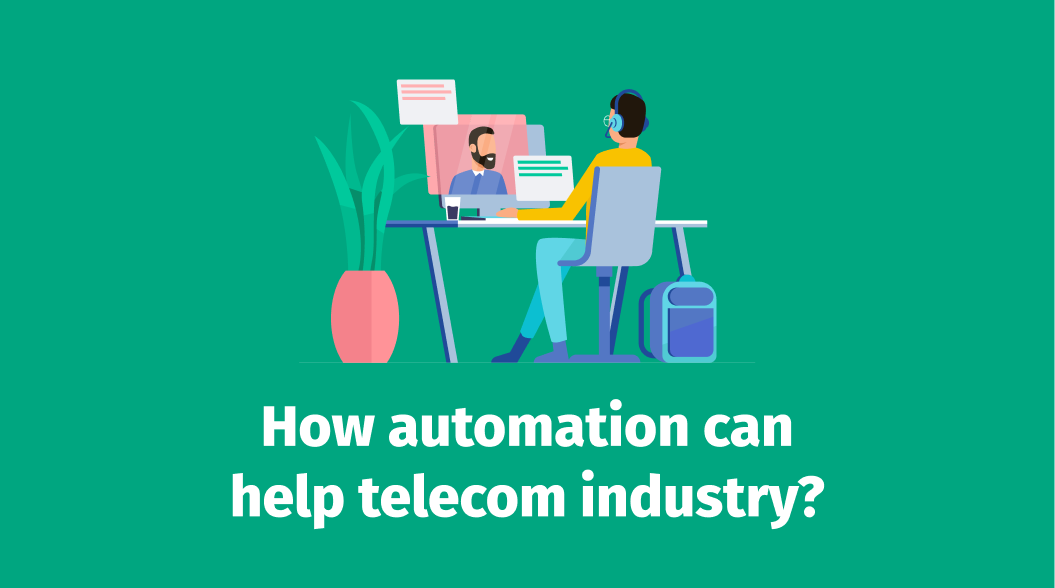Different ways of how RPA helps the telecom industries to overcome its challenges.
The best fit for robotic process automation is telecom industries. Before we see about robotic process automation, let’s see what are telecom industries first. Telecom industries are companies that make communication possible on a global scale. They have an infrastructure that allows data in text, voice, audio and video formats to be shared across the world. The telecommunication sector has three sub-sectors, telecom equipment, telecom services, and wireless communication.
Though telecommunication is well equipped with technology, as the days pass by there is an increase in the number of challenges it faces. This is when robotic process automation comes into play to help the company in providing innovative services to customers and stabilize performance efficiency in the organization.
Telecom industry has to strive hard to make uninterrupted, affordable and cutting edge services available to get a hold on their customers. Increase in demand for services in remote areas, cutting down operational costs, making business more agile, hiring & retaining top talent and improving business efficiency are the challenges that telecom industries are striving to deal with.
These issues can be overcome by adopting robotic process automation. Telecom industries are the best fit to take advantage of robotic process automation and get benefited in different ways. The list of things that trouble telecom industries are
Low-performance level
The employees in the back office had to deal with various applications, systems, and a database simultaneously with co-ordination which becomes challenging and impossible for humans sometimes. This lowers the performance efficiency of telecom companies.
Forbids proper information flow
Telecom industries have to deal with huge data each relating to different people like customers, sales personnel, network providers and engineers. A physical copy of these data is also stored which has to be maintained. These information are shared across multiple locations but there is a drop in the efficiency of sharing due to the overload of data. This hinders delivering a positive experience to the customers.
Higher operational costs
For providing security and protection to data, data integrity, maintenance, paying salaries to the increased number of headcounts, investing in technology equipment and marketing requires higher capital.
These roadblocks may seem threatening but can be overcome using robotic process automation.
Though telecom industries have incorporated technological advancements along the way, the next five years telecom will face accelerated advancement in robotic process automation. In this process, they are going to combine various technologies like data digitization, virtualization, the cloud, machine learning, artificial intelligence, robotics, IoT, telemetry and analytics.
Telecom industries will incorporate three levels of robotic process automation
- Level 1- Robotic process automation
- Level 2 - Knowledge-based Automation
- Level 3 - Cognitive Automation (AI, machine learning and analytics)
Here is the data which tells how RPA can add value to telecom industries:
- Order Entry: Recording the service parameters that are sold to the customers accurately
- Order Management: Each order is broken into subcomponents (fiber/CPE; voice/internet/security) and processed/tracked in simultaneously.
- Contract Management: Contracts are digitized/stored
- Supply Chain/Procurement: Creating eCatalogue and enabling eAuction.
- Service Delivery: Beginning with activation to test/acceptance, inventory and capacity management.
- Operations/Service Assurance: From service desk, auto-ticketing to self-healing.
- Billing/Revenue reconciliation: Ensuring alignment of service commitment to bills generated.
- Ability to scale operations: Without incurring additional costs, RPA can be deployed to various similar tasks and get benefited. By giving manual work to software robots, telecom service providers can scale better to different market scenarios.
- Cost reduction: Implementing new technology for business demands would increase investment. But the implementation cost of RPA is less when compared to Enterprise Resource Planning or Business process management software. The software license of RPA can be re-used for more than one process within the organization. Find similar tasks and implement automation. This way cost is reduced and the return on investment is increased.
- Accelerates efficient data flow: RPA can handle information from different sources and process it with efficiency. RPA is non-invasive which can easily go along with the existing setup. When you combine RPA with data analytics, you can get the best business benefits. Extracting required data and sharing is done with accuracy and efficiency.
Other benefits:
- Customer satisfaction
- Operational efficiency
- Business value
- Employee management
- Database management
- Reduces errors
- Reduced process time
Proper and step by step implementation can help in leveraging the fullest potential of RPA in telecom industries. Benefiting everyone involved in the process.
Up next
A Guide to Extracting Multiple Tables from Web Page with UiPath Skcript
/svr/how-automation-can-help-telecom-industry/
/svrmedia/heroes/[email protected]
Skcript
/svr/how-automation-can-help-telecom-industry/
/svrmedia/heroes/[email protected]
